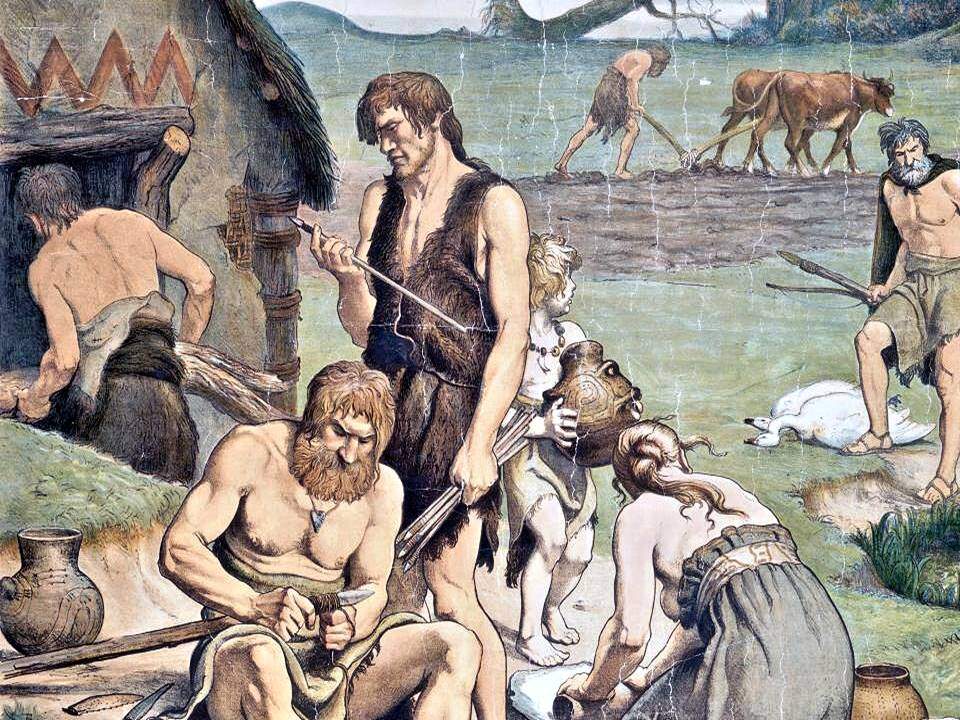Stone Age Facts for KS2
Before The Stone Age:
- 65 million years ago: Dinosaurs disappeared. (They became extinct)
- 7 million years ago: Small ape-like people appeared.
- 4 million years ago: The people grew bigger brains and began to walk upright. They had no tools and used their hands and teeth for everything.
- 2 million years ago: The people used stones for tools. They used broken pieces of flint which had sharp edges for cutting.
This is why we call this era the Stone Age.

The Stone Age is divided into three parts:
- The Old Stone (Palaeolithic Age)
- The Middle Stone (Mesolithic Age)
- The New Stone (Neolithic Age)
The Palaeolithic Age
- The Palaeolithic Age lasted from 50,000 years ago.
- People lived in caves because the country was covered in ice and snow.
- People used small flint stones for cutting meat with.
- They moved around to find their food.
- If they found an animal, they would eat it instantly.
- They could paint on walls.
The Mesolithic Age
- The Mesolithic Age was about 10,000 years ago.
- People lived in huts made from straw, wood and mud.
- They hunted with spears with stone arrowheads.
- They started to store food for over the winter.
- They kept dogs as pets.
- They could make pottery.
The Neolithic Age
- The Neolithic Age was about 6000 years ago.
- People started to live in small villages.
- They hunted with bows and arrows and caught fish in nets.
- They could plant seeds to grow crops.
- They kept animals contained on small farms.
- They could make jewellery.
- The Stone Age came to an end when people learnt how to use metal to make tools instead of stone.


Stone Age Homes.
During the Palaeolithic age, people only hunted and gathered they did not have shelters and lived in caves or under trees. Inside the caves they painted pictures of the way they lived and many of these paintings still survive today.
Mesolithic people learnt to build basic huts from poles covered by animal skin or straw. They were nomads, which means they rarely settled in places and usually lived in temporary campsites near water sources like rivers and streams. Archaeologists have found the remains of their camps by finding small holes in circles left in the ground.
By the Neolithic age, the single huts had developed small villages, they could farm animals and also buried their dead in graves. Often the dead were buried with food, weapons and jewellery.

Stone Age Food.
Palaeolithic people ate food as they found it. They were hunter-gatherers who got their food by hunting animals such as deer and boar. They would also find food in the forests like berries, nuts or wild vegetables.
Mesolithic people, however, learnt to keep some of their food (nuts and dried berries) for over the winter when little grows. They also learn how to catch fish in nets and had small canoe boats. They also learnt how to cook meat.
By the Neolithic period, people had learnt how to plant seeds and grow crops. They also learnt to keep animals in small enclosures like farms.

Stone Age Tools.
Palaeolithic Mesolithic tools were just pieces of smashed up stone. The stone was usually flint which has a sharp edge to it.
In the Palaeolithic era, people could take these pieces of sharp stone and wrap them onto sticks. These could then be used as spears for hunting or basic hammers for making shelters.
By the Neolithic period, people had learned how to carve the stones into arrowheads and very small fishing hooks. They could also smooth the stones into jewellery and necklaces.
There are lots of ways that we know about this era. The types of tools used and how complex they are tells us how old they are. Also, the fossiled remains of nuts, berries tells us what people ate. Evidence of burning tells us if they cooked food or not. Also, the bones left behind tell us what animals they ate.

